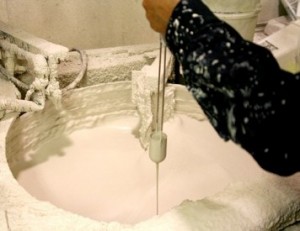How much time is spent thinking about slurry viscosity control? My guess is, not much. It seems to be a necessary evil of running a shell room, but not an area where we spend a lot of time.
What is the impact of the slurry viscosity being out of range? Operating outside of the targeted range could result in variations in shell thickness. If the back-up viscosity is running thick, then the mold weight could increase by up to 10%, especially in the later dips. If the viscosity is below the lower limit that could result in a thinner slurry layer and potential shell failures including run-outs or surface finish defects.
What is viscosity and why do we measure it? Viscosity is the measurement of a fluid’s resistance to flow, in our case, the slurry. A number of factors can impact the slurries viscosity, including liquid content (silica, water and polymer), particle size of the flour and temperature, to name a few.
Assuming a slurry is within specification for its key parameters, i.e. percent silica, temperature and refractory solids, the viscosity measurement is a value used in this industry which identifies how much slurry will be deposited on the wax pattern and/or previous dips. The ideal viscosity for slurry is dependent on the type of slurry and the part configuration. This is normally set by shell room management or by the supplier. The operator’s responsibility is to maintain the slurry within the designated range.
Viscosity is typically measured using a viscosity cup or in some instances a viscometer. Most commercial foundries using a viscosity cup establish a 2-second range and try to maintain the viscosity within that range.
However, the different techniques used by operators while measuring viscosity can have an impact on the value they record.
- To Rinse or not to Rinse: If the cup is stored in water, is it rinsed with slurry prior to taking a reading?
- Why Stop at One Reading: How many readings should be taken prior to recording?
- Location, Location, Location: Where in the tank is the slurry most uniform?
- Blink or ¼” stream: Are the operators looking for a blink or a stream break? If a stream break, what distance from the cup?
How you measure viscosity isn’t as important as ensuring that all your operators are doing it the same way. The amount of time it takes for a slurry to flow through a cup is relative, not absolute. But, you want your operators to minimize the variation.
Some operators are very comfortable taking viscosity readings. Inevitably, there will be an operator who is not comfortable measuring viscosity and his readings will be significantly different from the other operators. If the slurry is being adjusted based on this operator’s reading, the slurry could be adjusted to be out of the range.
Once you understand how viscosity control is being managed, you can start to address the variations. Training them not only on the viscosity procedure but also on why viscosity is important can go on long way towards improving viscosity control.
The final step is to continue to follow up on a regular basis to ensure that the operators are following the established procedure and reinforce the importance of viscosity control.
